On the evening of August 27, 1859, a well under the supervision of Colonel Edwin L. Drake (1819-1880), who was employed with the Seneca Oil Company, struck petroleum at a depth of seventy feet near Titusville, Pennsylvania. Petroleum or “rock oil” had long been known to be prevalent in Pennsylvania, but it was never valued due to a lack of practical uses in addition to difficulty drilling for it. Oil had long been considered useful for medicinal purposes or as a lubricant for machinery, but was just becoming valuable for use as an illuminant (i.e. lamps). Other wells – mainly built to seek salt – had struck oil before, but Drake’s well is considered the first purpose-built well designed specifically to go after petroleum.
With Drake’s discovery a frantic oil boom got underway in the Oil Creek region of northwest Pennsylvania and just like that the modern petroleum industry was born. In the coming months speculators leased every available stretch of property and began drilling, often in dangerous conditions, to stay ahead of rival outfits. These pioneering wells were producing only 1,200 barrels a day total by the end of 1860. A year later the famous Empire well, the first great oil producing site, was producing 3,000 barrels a day by itself. The Empire well was soon eclipsed by numerous other wells producing at great volume. Many people, from small speculators to company executives, became instantly wealthy.
For the first five years of the oil boom (1859-1864) there was little reason to explore sites outside the productive Oil Creek valley. In the summer of 1864 the first “wildcat” wells, those drilled for exploration purposes in unproven areas, were dug in the outlying areas. Speculators soon began spreading outward from the Oil Creek valley and seeking untapped oil reserves. Before long the entire region of northwest Pennsylvania was dotted with oil wells and the state was responsible for most of the nation’s petroleum supply. From 1870-1875 the oil men found great success in the “Lower Oil Belt” consisting of a field in the triangle of Clarion, Butler, and Armstrong Counties.
The greatest find yet was the massive Bradford oil field in McKean County, which was mainly exploited from 1875-1881. The town of Bradford, near the border with New York, grew from a population of 500 people in 1875 to over 11,000 people in just five years. Over 7,000 wells were producing a then-staggering 65,000 barrels a day. During its heyday Bradford was the center of the oil universe and responsible for about 77% of the world’s petroleum supply.
With such mass production the price of petroleum quickly fell and the “oil rush” in northwest Pennsylvania was over by the late 1870’s. The Pennsylvania oil industry peaked in 1891, and within a few years Ohio became the leading oil-producing state. After the turn of the century attention shifted towards vast oil reserves discovered in Oklahoma, California, and Texas. It wasn’t until the late 1920’s that the Middle East region, with the world’s largest supply of accessible oil reserves, began coming into prominence. The advent of electricity led to a brief decline in the importance of petroleum (as an illuminant), however the rise of modern conveyances such as automobiles furthered its importance like never before.
Lawrence County was never a major player in the oil rush. The first serious operation was the Strawbridge well dug in 1860 about a mile and a half above Edinburg in Mahoning Township. A small amount of oil was discovered and great excitement ensued. Other wells were soon dug in the same area, but swampy conditions made extracting the petroleum almost impossible. Within five years the area was completely abandoned to drilling. Other areas where drilling was prevalent were at Big Run near New Castle and along the Slippery Rock Creek in eastern Lawrence County. By the 1890’s the county was dotted with many small wells, but none were of any real significance.
In the early 1900’s an extensive oil field was discovered at Bessemer near the border with Ohio. The New Castle News of March 27, 1909, reported, “The oil excitement is now in full sway at Bessemer and vicinity, and residents of that part of the county are greatly worked up over the prospect of additional leases being taken in that part of Lawrence county. The Midland Oil company, composed of the most part of Lawellville (sic) businessmen, have just completed their last well in the vicinity at Bessemer, where they already have several large and paying wells.”
By 1914 there were about 900 wells operating in the oil field, which stretched from Bessemer southward to Mount Jackson. About half a dozen oil companies were involved in the drilling, which was decent but nothing compared to the success of other more famous oil fields. Large pockets of natural gas were also discovered and exploited throughout the region as well. In early 1915 another significant drilling operation got underway on the Walter Raub farm west of Edinburg. These fields in western Lawrence County generally remained in operation throughout the 1920’s and were then mostly abandoned. The major oil companies ceased operations, although a handful of small independent wells remained in active service.
A successful oil well was drilled on the John Baird farm, over a mile east of Hillsville, in the summer of 1934 and this launched a renewed (but smaller) oil boom in the Bessemer-Edinburg district. These were all small producers but good for some additional income. The last well in the Bessemer field was shutdown in the early 1950’s.
Flash forward to 2006 when the rush for exclusive land rights is underway as energy companies sought to exploit the Marcellus Shale range, a sedimentary rock formation stretching across New York-Pennsylvania-Ohio-West Virginia that is incredibly rich in crude oil and natural gas reserves. The value of the Marcellus Shale had long been known, but getting to these deposits has never been technologically or economically feasible.
Recently implemented techniques involving horizontal drilling and hydraulic fracturing (or “fracking”) had proved the oil and gas deposits, often at depths of over 5,000 feet in Lawrence County, could be successfully extracted. The controversial technique of fracking, the process of forcing pressured water and chemicals deep into the ground, cracks the shale rock formation and releases valuable gas and oil deposits to the surface. Unlike New York, where fracking has been banned since 2008, Pennsylvania has been a lucrative market for such techniques.
The first well in operation in Lawrence County was on the property of Harry J. Patterson, located on Mt. Air Road in Little Beaver Township. The Shell Western Exploration and Production Company (SWEPI) began work there in about August 2011, and the site began producing natural gas (pumped into a pipeline) in February 2013. During 2013 there were about nineteen wells in operation at five different sites in the county and many more wells are coming. Several underground pipelines are also in operation or in the planning stages.
The drilling companies maintain the process of fracking is safe and creates jobs, while environmentalists and activists warn of the dangers of ground contamination, explosions that could threaten workers, and geysers of fire traveling through old abandoned wells and other fissures. The Marcellus Shale oil and natural gas boom was brought wealth to some land owners and provided jobs for many unemployed workers, but has also embroiled Lawrence County in one of the most controversial issues in its history.
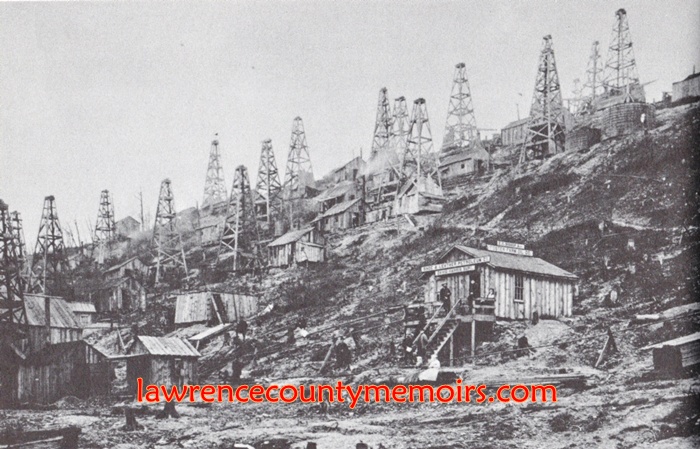 A typical scene along the Oil Creek Valley during the oil boom. Oil was discovered at the confluence of Oil Creek and Pioneer Run in the early 1860’s, and before long wells sprung up all over the area. The town of Pioneer was established here and became a vital shipping point. (1865) Full Size |
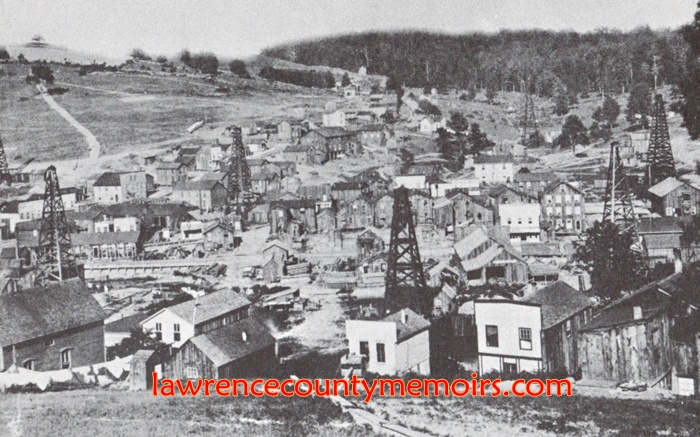 In 1870 wildcatters began moving southward into the “Lower Oil Belt” of Clarion-Butler-Armstrong Counties. In early 1872 oil was struck in the wilderness area of eastern Butler County, and before long the town of Petrolia (shown above) was established. The town quickly reached a peak of 5,000 inhabitants, but as the oil industry moved within a few years the town was reduced to a sleepy settlement. (c1873) Full Size |
 After the success of Petrolia another wildcat well struck oil a mile to the south in the summer of 1872. The town of Karns City, named in honor of oil man S. D. Karns, was established and for a year or so was the largest producer of oil in Pennsylvania. (c1874) Full Size |
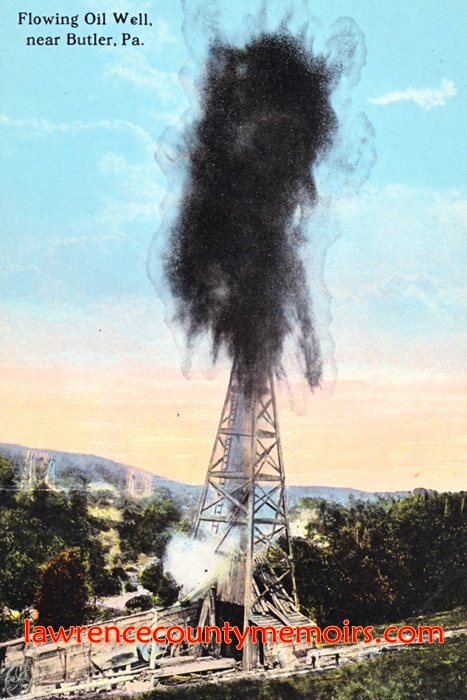 An oil well in Butler County spouts “black gold.” (c1906) |  This old photo is marked as “Near New Castle PA” and is presumably showing an oil well near Bessemer in western Lawrence County. (c1906) |
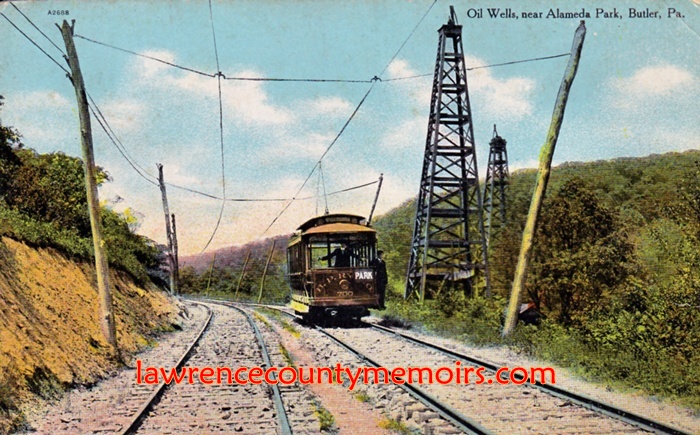 A streetcar passes near an oil well near Alameda Park, located northwest of downtown Butler. A series of wells were dug in this area in 1907-08. (c1910) Full Size |
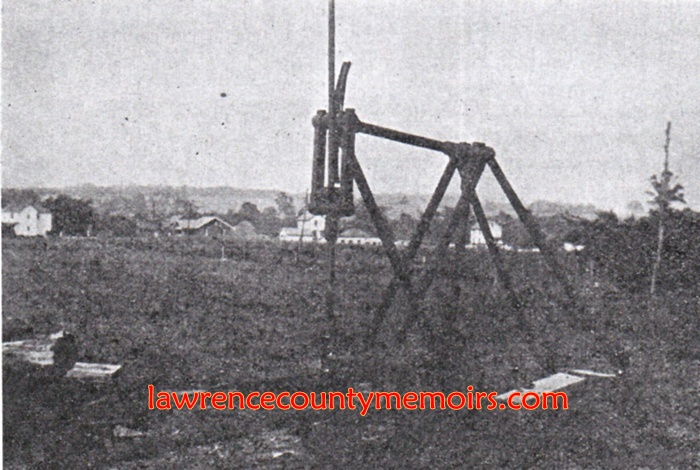 This photo, taken at Bessemer, shows what appears to be an early pumpjack-style rig. In the early 1900’s an extensive oil field was discovered near Bessemer, the largest in Lawrence County, and eventually as many as 1,500 oil wells were put in operation. (c1915)Full Size |
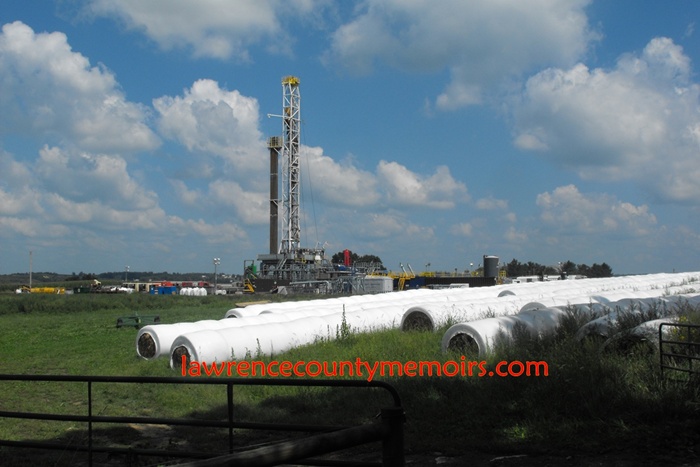 A modern drilling rig, utilizing controversial “fracking” methods, designed to reach the natural gas in the Marcellus Shale range. This is the Kephart well, an exploratory site drilled by the Shell Western Exploration and Production Company (SWEPI), in North Beaver Township just southwest of Mount Jackson. Work on this site began in August 2012 and drilling operations commenced a few months later. (Oct 2013) Full Size |
 A commemorative license plate promoting the history of Venango County. |
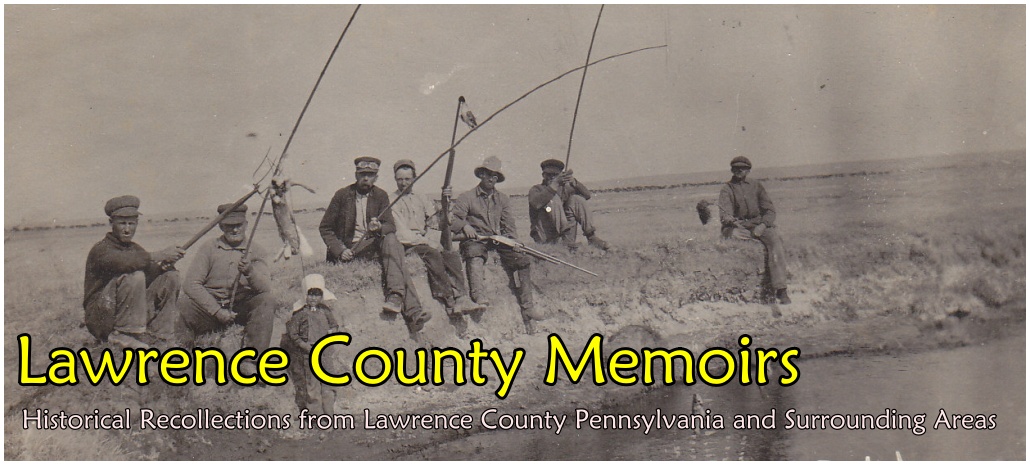



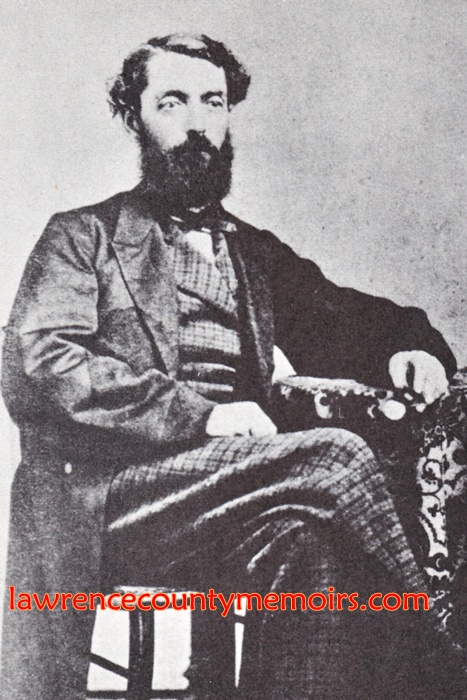


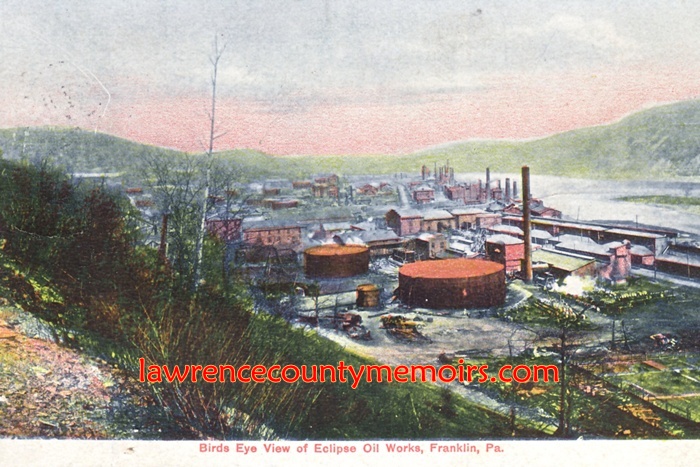

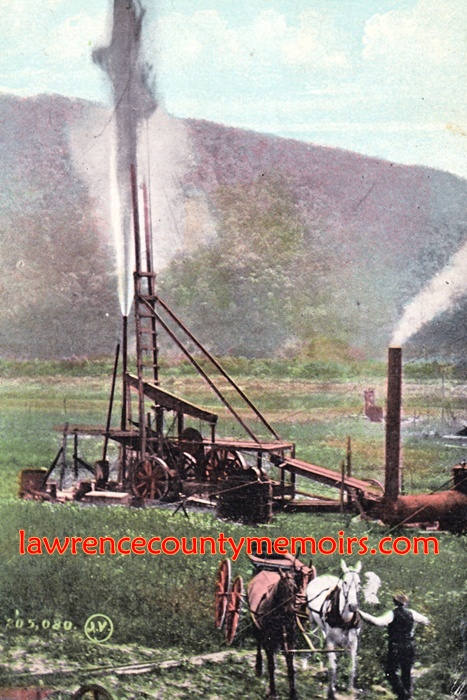
Comments
Bruce McClelland #
The oil field near Bessemer/ Hillsville last produced in the early 1950’s on the old Baird farm. The pumping system was powered by sucker rods receiving motion from a large engine in a pump house next to the barn. This operation was on the north side of Mt.Jackson-Hillsville Rd about 1 mile East of Hillsville.
Name Withheld to Protect the Innocent #
As kids in the 50’s & 60’a, we’d hike back through the woods into the meadows between Bessemer and Hillsville (just before the limestone quarries) and there would be barren patches of ground (still too contaminated to let grass grow over them) and there were also large patches of hardened black tar, wood timbers and bits of iron equipment laying about. I just checked it out on Google Earth and that area is still an abandoned wasteland. By the way for those who are interested, there’s a large pawpaw tree patch in those woods closest to the Ohio state line. It was recorded as the farthest north that pawpaws were found growing in the U.S. Just another thought, it would be nice to know some history about that tall old limestone tipple that stood in what locals termed “the midlands” northeast of Bessemer.
Jeff Bishop #
Surprised that there was no mention of the “New Castle – Franklin RR” that ran up along the Neshannock Creek. Its purpose was to bring oil into New Castle for refining. Phillips (who lived across the street from the Scottish Rite Cathedral) at the corner along Highland Avenue, was “the” Phillips of Phillips 66. They had a refinery located down on the flats between the Paper Mill Bridge and El Rio Beach in New Castle.
The N.C.-Franklin Rail Roads main purpose was to bring oil in from the “oil regions” of Franklin and Oil City. It also hauled freight and offered a regular passenger service.
Information above referenced from “The History of Lawrence County.” Available online and possibly still in book form at the Lawrence County Historical Society.
I am a history buff from New Castle (Neshannock); currently residing in Phillips, ME.
Michael Lee Stills #
Dear Name Withheld. I would love to see a photo of that Limestone Tipple.
I found a brief article about my grandfather as a kid.
On The Head, New Caslte News 23Nov1898, page 10.In the article he attempted to jump from a train that was nearing the Limestone Tipple and caught a projection that threw him to the ground injuring him. My Mom never heard this story and I never met my grandfather.
Jeff Bales (EDITOR) #
(EDITOR’S NOTE) Jeff Bishop, Thanks for the post. I’ll try to add something about T. W. Phillips and his endeavors – and the New Castle-Franklin Railroad. Good idea. Keep in mind his Butler-based company became known as T. W. Phillips Gas & Oil in about 1904. What became “Phillips 66” is a Texas-based company founded by L. E. Phillips and Frank Phillips in 1917 and is not associated with him. Thanks. Jeff
David McCORMICK #
In 1917, the Bunny brothers, Charles & William drilled 17 wells in the valley of the Big Run (largely in Slippery Rock Township). I hope I spelled the surname correctly. Only two or three wells produced commercially into the mid-1920s. They were fairly shallow wells ranging from 600 to 1000 feet in depth. After being “shot” with nitro, two or three of the wells became artesian water wells. At least two of those are still (2017) spouting water.
Dennis Moore #
Check out the Muddy Creak Oil field museum near Prospect PA. See some video on You Tube.
Gary Fleeger #
I think the most interesting story about oil and gas in Lawrence County is that the Slippery Rock oil field along the Slippery Rock Gorge was discovered because of an oil seep at a ford across the stream near Armstrong Bridge. The oil seeped across a large flat rock on the ford. It was notoriously slippery, and is the origin of the name Slippery Rock.
Comment